Wildcat Rover V8 in Mod Griffith chassis
Discussion
Kokkolanpoika said:
Yes i have got 90mm forged crank. Our machine shop also say that it will look forged item.. It will weight approx 25Kg without rods´s etc.. STD 4.6 crank will weight only approx 20Kg
I bought my engine 2nd hand from RPI many year´s ago. They say it will make very small tapping sound and found that it has got one approx 0.05mm smaller piston and it might get that sound. Bore clearance is 0.16mm when i measure it. It has got ross forged piston´s and Manley 5.85" rod´s and crank has got laser writet text Rover 91mm. But it has got 90mm when i measure it.
Piston has got in the midle big valve pocket´s witch wont fit in the rover valve´s. So i also have to cut more valve pocket´s..

This is the picture what RPI sent..

When home.


I found bigger problem from that noise what RPI say´s.. 2x rod bolt´s will hit block oil gallery tunnel, there is zero clearance and crank will stop straight away.. I did not resolve how this engine can be 2nd hand unit direct from drive.. i ask this from them, and they did not get answer, they say that send engine back to them, and they can resolve my problem.. No i did not send it, i will machine some metal from bolt, block and rod to get more room..

It has got mutch wider parting line in the centre of crank also..
Looks like a Forged Steel crankshaft to me. I was quoted £2,500 a few year ago.I bought my engine 2nd hand from RPI many year´s ago. They say it will make very small tapping sound and found that it has got one approx 0.05mm smaller piston and it might get that sound. Bore clearance is 0.16mm when i measure it. It has got ross forged piston´s and Manley 5.85" rod´s and crank has got laser writet text Rover 91mm. But it has got 90mm when i measure it.
Piston has got in the midle big valve pocket´s witch wont fit in the rover valve´s. So i also have to cut more valve pocket´s..

This is the picture what RPI sent..

When home.


I found bigger problem from that noise what RPI say´s.. 2x rod bolt´s will hit block oil gallery tunnel, there is zero clearance and crank will stop straight away.. I did not resolve how this engine can be 2nd hand unit direct from drive.. i ask this from them, and they did not get answer, they say that send engine back to them, and they can resolve my problem.. No i did not send it, i will machine some metal from bolt, block and rod to get more room..

It has got mutch wider parting line in the centre of crank also..
Edited by Kokkolanpoika on Friday 15th January 15:17
As you bought your engine a few years ago second hand, you might find a replacement engine, to the same spec would cost a lot more now.
You have skills (Nice fix)
precat
I do not have better pic of my head´s than this. And find only one piece my 2012 season dyno print on my computer. Here on PH forum might be 2013 Dyno print?
It has got 340rwhp and 381hp 5560rpm/543Nm 3910rpm flywheel with 2012 season, it will run 10.5 or 10.8CR, Haltech engine magnament with batch fire mode.
2013-2014 season is 11.8CR and megasquirt semisequential fuel and COP made approx +6hp more at rear wheels. And +13Nm. It has got 346hp @ wheels and 556Nm of torque. I do not rememper what RPM. But it will produse more power and torque lower RPM, approx 200rpm lower..
2012.

This is old slightly under 400hp setup.. 43/38mm valves, throat 85% diameter, inlet 36.55mm.
This is where all start. Stupid copper ex seat, i did not order it..

Tested couple of years, head gasket start to leak slightly and get more compression same time.



New setup after year´s. Found 1 pick more. Have to take some new pick´s in future.
38mm exhaust valve in the inlet port.. There is room to move valves slightly sideways also if hit valve guide. Throat diameter 90% of valve diameter = 38.7mm, but hand ported with offset.

Another port is untoutched. Also i fit new valve seat´s on exhaust side, because those copper colored seat will pitted too often, and will start to leak slightly.
It has got 340rwhp and 381hp 5560rpm/543Nm 3910rpm flywheel with 2012 season, it will run 10.5 or 10.8CR, Haltech engine magnament with batch fire mode.
2013-2014 season is 11.8CR and megasquirt semisequential fuel and COP made approx +6hp more at rear wheels. And +13Nm. It has got 346hp @ wheels and 556Nm of torque. I do not rememper what RPM. But it will produse more power and torque lower RPM, approx 200rpm lower..
2012.

This is old slightly under 400hp setup.. 43/38mm valves, throat 85% diameter, inlet 36.55mm.
This is where all start. Stupid copper ex seat, i did not order it..

Tested couple of years, head gasket start to leak slightly and get more compression same time.



New setup after year´s. Found 1 pick more. Have to take some new pick´s in future.
38mm exhaust valve in the inlet port.. There is room to move valves slightly sideways also if hit valve guide. Throat diameter 90% of valve diameter = 38.7mm, but hand ported with offset.

Another port is untoutched. Also i fit new valve seat´s on exhaust side, because those copper colored seat will pitted too often, and will start to leak slightly.
Edited by Kokkolanpoika on Friday 15th January 18:33
Here's the latest
Back in December 2014, I commissioned someone to sort out a Griffith body that will fit my modified Griffith chassis. The estimated time frame given was six months. Currently the work is 55% complete. Hoping to get the modified body back later this year. I'm still motivated and visit the workshop in question twice a month.
wildcat600
Back in December 2014, I commissioned someone to sort out a Griffith body that will fit my modified Griffith chassis. The estimated time frame given was six months. Currently the work is 55% complete. Hoping to get the modified body back later this year. I'm still motivated and visit the workshop in question twice a month.
wildcat600
I was asked to post some information on the (relatively) new TA Performance Rover heads as I just finished having some work done to a set and had them flow tested. A bit of background is in order before I post the numbers. I've got a couple of Rover V8's that I'm messing with. The one these heads are destined for is a 4.2L and was purchased as a bunch of parts from someone else's abandoned project. The parts list on that one includes a cross-bolted block, stock 3.03" stroke crank, narrowed 6.2" Carrillo forged h-beam connecting rods and forged Wiseco pistons. Intake manifold is a Willpower single plane with bungs for EFI. Camshaft will be either a solid flat tappet or a hydraulic roller. Headers will be Triumph TR8 tri-y's (1 5/8" primary, 1 7/8" secondary, 2 1/4" collectors). Target compression is 11:1 and the engine will go in a street driven 1980 Triumph TR8 convertible that will never see a race track.
I had originally purchased a bare set of TA Performance Rover heads and had been sitting on them until I finished another car project. A few weeks back I got a call from another TR8 owner with a 4.9L Rover. His engine was built by the Wedge Shop and dyno'd at 391 HP @ 6300 RPM and 357 ft-lbs @ 5000 RPM with a Harcourt single plane intake manifold and a set of ported Rover cylinder heads from John Eales. He has since installed side draft Webers and purchased a set of assembled but unported TA Performance Rover heads. However, the TA heads are not a direct replacement head. The exhaust is raised 3/4", the valves are relocated towards the bore centerline to permit the larger diameter valves, the heads require a custom valley pan, etc. When he figured out how much work would be needed to fit the heads to his already assembled engine, he decided to sell them and offered them to me at a price I couldn't pass up. A couple of weeks ago, I dropped them off at a local head porter for an evaluation, along with the Willpower intake, an exhaust flange, some gaskets and a cylinder block for mock up purposes.
I removed the valves from one cylinder and the porter (Bob Stiegemeier) examined the ports, chamber shrouding, seat margins and valve angles and asked me some questions about the engine the heads will be going on. He also asked if I was going to run EFI or a carb, suggesting you can get away with larger ports with EFI. He thought the size of the as cast intake ports were fine, needing only detail work, and that the best bang-for-the-buck would be to work around the existing valve job. He also threaded a spark plug in and indicated he would do a little chamber work around the plugs. Since the heads were assembled, we decided the best bang-for-the buck would be to work around the existing valve job. Looking at the intake ports, Bob thought they should go to 250 CFM fairly easily which would be plenty for my application. Bob used to do development work on NASCAR intake manifolds and said getting the port floor of the intake manifold to work with cylinder head port floor was especially critical. Also, the developer of the heads, Mike Tomaszewski of TA Performance, posted the following on porting the TA Rover heads:
"On the exhaust have him start by opening up the exhaust outlet, make the port wider, The port will respond by doing this. Then have him remove very little to none on the back side of the exhaust bowl. Just blend the machined throat area into the back side. He should end up with a slight bump even, on the back side. Blend the rest of the bowl how he sees fit."
I picked up the ported TA Rover heads today and posted the following on another forum:
Heads were ported by Bob Stiegemeier of Stiegemeier Porting Service (http://stiegemeier.com/) in St. Charles, Missouri and were tested at a 28" pressure drop on a SuperFlow 600 flow bench. Intake ports were flowed with a clayed radius around the intake port. No pipe was used on the exhaust except for one test with the stock 4.6L Rover head (noted below). Flow is in cubic feet per minute (CFM) and lift is in inches. Intake valve diameter is 1.94" and exhaust diameter is 1.6". Note that the heads were purchased assembled and Bob worked around the existing valve job. For my application, only minor work was required on the intake side so most of the effort was concentrated on the exhaust. Heads were flowed unported, ported and ported with a 30 degree back cut on the intake valves. Columns are as follow:
1 = out of box intake ports
2 = ported intake, no back cut on intake valves
3 = ported intake, 30 degree back cut on intake valves
4 = out-of-box exhaust ports, no pipe stub
5 = ported exhaust, no back cut on exhaust valves, no pipe stub
I'll try inserting periods to keep the forum software from screwing up the column spacing:
Valve....1........2.........3........4........5
Lift.....1.94....1.94....1.94...1.60...1.60
(Inch)..CFM..CFM..CFM..CFM..CFM
0.100 067.7 076.8 078.3 047.9 063.8
0.200 105.4 120.4 129.4 070.2 108.5
0.300 143.0 173.1 185.1 102.1 146.7
0.350 164.0 198.7 206.2 114.9 -------
0.400 185.1 224.2 225.8 126.0 177.0
0.500 220.9 255.9 251.3 137.2 189.8
0.600 225.8 ------- 252.8 140.4 199.4
Bob noted the flow for the ported intake with back-cut valves was for the first one he did. He got closer to 260 CFM peak on subsequent valves. He believes he can do better if starting with heads without a valve job. The exhaust port was sized for a 1 5/8" OD header primary (the larger of the two available tri-y headers for the Triumph TR8). For reference, here's what my ported 1964 Buick 300 cylinder heads flowed with 1.775" intake and 1.5" exhaust valves:
Lift 1.775 1.5
0.100 066 047
0.200 129 104
0.300 174 130
0.350 187 139
0.400 191 146
0.500 196 152
0.600 200 153
I had also previously flowed a stock Buick 300 head with 1.625" intake and 1.312" exhaust valves at 154 CFM intake and 116 CFM exhaust. The unported Rover 4.6L head flowed:
Lift 1.575 1.350
0.100 060.2 057.4
0.200 105.4 092.5
0.300 132.4 103.7
0.350 135.5 106.9
0.400 135.5 106.9 (114.8 with pipe stub)
The ported TA Rover heads flow nearly double the stock Rover 4.6L heads! I dug up some small block Ford AFR 165 head flow numbers (CNC ported but earlier version with the 11/32" diameter valves) from a magazine article (Mustang 5.0 magazine, November, 2000, "Having our Heads Examined"):
AFR 165 1.9 1.6
0.100 060 051
0.200 123 108
0.300 176 149
0.400 210 174
0.500 232 184
0.600 232 188
Note the ported Rover TA heads outflow the highly regarded AFR 165 heads (best of the smaller valve size, stock port location, SBF heads).
Bob clearanced the chambers to around 42cc then milled them 0.020" to get them to 37cc. He also installed thin wall bronze sleeves in the pushrod holes. The intake valves had sharp edges around the keepers and damaged some of the valve stem seals during dis-assembly so he smoothed the sharp edges and installed new seals. The intake valves (appear to be SI brand) were out of round so Bob cut them to get them round. The exhaust (Ferrea) were round and needed no adjustment. The intake manifold had a low spot on one of the flanges that he welded up and milled back down. The intake and heads were then port matched on the block. He tested the springs with and without the inner springs. With the inners in place, they are 170 lbs on the seat and 400 lbs @ 0.550" lift. With the inners removed, they are 120 lbs on the seat and 280 lbs @ 0.550". Bob said he can adjust the seat pressure with offset keepers once I decided on the cam. He'd really like to see me run a solid flat tappet cam with EDM lifters and beehive springs and spin the engine to 8000 RPM. Given the intake port size, he thought I'd want to run a narrower lobe separation angle than the intake valve diameter (to cubic inches ratio) might suggest with a bunch of initial timing and a short advance curve. He also suggested 11:1 compression and thought EFI would work better than a carb with the large intake ports. Given the very strong exhaust port, he thought a single pattern cam would be the way to go. He mentioned that while the exhaust would flow even more with a pipe stub, adding a full length header usually gets it back to what the naked exhaust port flows so he likes to flow them without a pipe stub. Bob was really jazzed about the TA heads and lightweight Rover V8. He noted there was room on the cylinder head to raise the roof a 1/2" and thought that raising the roof, filling the floor and use a larger intake valve, he could get well over 320 CFM out of the intake ports.
Photos to follow later this week or weekend.
Dan Jones
I had originally purchased a bare set of TA Performance Rover heads and had been sitting on them until I finished another car project. A few weeks back I got a call from another TR8 owner with a 4.9L Rover. His engine was built by the Wedge Shop and dyno'd at 391 HP @ 6300 RPM and 357 ft-lbs @ 5000 RPM with a Harcourt single plane intake manifold and a set of ported Rover cylinder heads from John Eales. He has since installed side draft Webers and purchased a set of assembled but unported TA Performance Rover heads. However, the TA heads are not a direct replacement head. The exhaust is raised 3/4", the valves are relocated towards the bore centerline to permit the larger diameter valves, the heads require a custom valley pan, etc. When he figured out how much work would be needed to fit the heads to his already assembled engine, he decided to sell them and offered them to me at a price I couldn't pass up. A couple of weeks ago, I dropped them off at a local head porter for an evaluation, along with the Willpower intake, an exhaust flange, some gaskets and a cylinder block for mock up purposes.
I removed the valves from one cylinder and the porter (Bob Stiegemeier) examined the ports, chamber shrouding, seat margins and valve angles and asked me some questions about the engine the heads will be going on. He also asked if I was going to run EFI or a carb, suggesting you can get away with larger ports with EFI. He thought the size of the as cast intake ports were fine, needing only detail work, and that the best bang-for-the-buck would be to work around the existing valve job. He also threaded a spark plug in and indicated he would do a little chamber work around the plugs. Since the heads were assembled, we decided the best bang-for-the buck would be to work around the existing valve job. Looking at the intake ports, Bob thought they should go to 250 CFM fairly easily which would be plenty for my application. Bob used to do development work on NASCAR intake manifolds and said getting the port floor of the intake manifold to work with cylinder head port floor was especially critical. Also, the developer of the heads, Mike Tomaszewski of TA Performance, posted the following on porting the TA Rover heads:
"On the exhaust have him start by opening up the exhaust outlet, make the port wider, The port will respond by doing this. Then have him remove very little to none on the back side of the exhaust bowl. Just blend the machined throat area into the back side. He should end up with a slight bump even, on the back side. Blend the rest of the bowl how he sees fit."
I picked up the ported TA Rover heads today and posted the following on another forum:
Heads were ported by Bob Stiegemeier of Stiegemeier Porting Service (http://stiegemeier.com/) in St. Charles, Missouri and were tested at a 28" pressure drop on a SuperFlow 600 flow bench. Intake ports were flowed with a clayed radius around the intake port. No pipe was used on the exhaust except for one test with the stock 4.6L Rover head (noted below). Flow is in cubic feet per minute (CFM) and lift is in inches. Intake valve diameter is 1.94" and exhaust diameter is 1.6". Note that the heads were purchased assembled and Bob worked around the existing valve job. For my application, only minor work was required on the intake side so most of the effort was concentrated on the exhaust. Heads were flowed unported, ported and ported with a 30 degree back cut on the intake valves. Columns are as follow:
1 = out of box intake ports
2 = ported intake, no back cut on intake valves
3 = ported intake, 30 degree back cut on intake valves
4 = out-of-box exhaust ports, no pipe stub
5 = ported exhaust, no back cut on exhaust valves, no pipe stub
I'll try inserting periods to keep the forum software from screwing up the column spacing:
Valve....1........2.........3........4........5
Lift.....1.94....1.94....1.94...1.60...1.60
(Inch)..CFM..CFM..CFM..CFM..CFM
0.100 067.7 076.8 078.3 047.9 063.8
0.200 105.4 120.4 129.4 070.2 108.5
0.300 143.0 173.1 185.1 102.1 146.7
0.350 164.0 198.7 206.2 114.9 -------
0.400 185.1 224.2 225.8 126.0 177.0
0.500 220.9 255.9 251.3 137.2 189.8
0.600 225.8 ------- 252.8 140.4 199.4
Bob noted the flow for the ported intake with back-cut valves was for the first one he did. He got closer to 260 CFM peak on subsequent valves. He believes he can do better if starting with heads without a valve job. The exhaust port was sized for a 1 5/8" OD header primary (the larger of the two available tri-y headers for the Triumph TR8). For reference, here's what my ported 1964 Buick 300 cylinder heads flowed with 1.775" intake and 1.5" exhaust valves:
Lift 1.775 1.5
0.100 066 047
0.200 129 104
0.300 174 130
0.350 187 139
0.400 191 146
0.500 196 152
0.600 200 153
I had also previously flowed a stock Buick 300 head with 1.625" intake and 1.312" exhaust valves at 154 CFM intake and 116 CFM exhaust. The unported Rover 4.6L head flowed:
Lift 1.575 1.350
0.100 060.2 057.4
0.200 105.4 092.5
0.300 132.4 103.7
0.350 135.5 106.9
0.400 135.5 106.9 (114.8 with pipe stub)
The ported TA Rover heads flow nearly double the stock Rover 4.6L heads! I dug up some small block Ford AFR 165 head flow numbers (CNC ported but earlier version with the 11/32" diameter valves) from a magazine article (Mustang 5.0 magazine, November, 2000, "Having our Heads Examined"):
AFR 165 1.9 1.6
0.100 060 051
0.200 123 108
0.300 176 149
0.400 210 174
0.500 232 184
0.600 232 188
Note the ported Rover TA heads outflow the highly regarded AFR 165 heads (best of the smaller valve size, stock port location, SBF heads).
Bob clearanced the chambers to around 42cc then milled them 0.020" to get them to 37cc. He also installed thin wall bronze sleeves in the pushrod holes. The intake valves had sharp edges around the keepers and damaged some of the valve stem seals during dis-assembly so he smoothed the sharp edges and installed new seals. The intake valves (appear to be SI brand) were out of round so Bob cut them to get them round. The exhaust (Ferrea) were round and needed no adjustment. The intake manifold had a low spot on one of the flanges that he welded up and milled back down. The intake and heads were then port matched on the block. He tested the springs with and without the inner springs. With the inners in place, they are 170 lbs on the seat and 400 lbs @ 0.550" lift. With the inners removed, they are 120 lbs on the seat and 280 lbs @ 0.550". Bob said he can adjust the seat pressure with offset keepers once I decided on the cam. He'd really like to see me run a solid flat tappet cam with EDM lifters and beehive springs and spin the engine to 8000 RPM. Given the intake port size, he thought I'd want to run a narrower lobe separation angle than the intake valve diameter (to cubic inches ratio) might suggest with a bunch of initial timing and a short advance curve. He also suggested 11:1 compression and thought EFI would work better than a carb with the large intake ports. Given the very strong exhaust port, he thought a single pattern cam would be the way to go. He mentioned that while the exhaust would flow even more with a pipe stub, adding a full length header usually gets it back to what the naked exhaust port flows so he likes to flow them without a pipe stub. Bob was really jazzed about the TA heads and lightweight Rover V8. He noted there was room on the cylinder head to raise the roof a 1/2" and thought that raising the roof, filling the floor and use a larger intake valve, he could get well over 320 CFM out of the intake ports.
Photos to follow later this week or weekend.
Dan Jones
Transmitter Man said:
DA,
Isn't this thread about the Rover V8 and a Griff?
Surely you're interested in other peoples work in improving the performance of the beast regardless of it's displacement.
What's a few CC's between friends?
Phil
Absolutely but there is no denying that the 'faffometer' kicked in for the RV8 back at around 350bhp Isn't this thread about the Rover V8 and a Griff?
Surely you're interested in other peoples work in improving the performance of the beast regardless of it's displacement.
What's a few CC's between friends?
Phil

It's fascinating learning more about how people are advancing the unit and extracting more but I think the most interesting question to pose is whether this will ever lead to an off the shelf, turnkey and vaguely affordable solution for an easy and reliable 400x400 engine?
It's a bit like the Moon Program, some of us are still waiting for our bloody Moon Base which we were promised.

As you know, people have been banging on about the deficiencies of the Rover head since it's inception.
If TA thought it worthwhile to go to the expense of designing a new RV8 head and with their previous Buick V8 development experience I think we could be that much closer to an off the shelf 400hp Rover build package.
I sure hope so.
If TA thought it worthwhile to go to the expense of designing a new RV8 head and with their previous Buick V8 development experience I think we could be that much closer to an off the shelf 400hp Rover build package.
I sure hope so.
I read with interest the information on TA heads. When carrying out some of my own research, I was lucky enough to locate a pair of TA Heads to compare with a pair of Wildcat heads. I was surprised to find how similar the TA heads are to Wildcat. Given Wildcat started producing these heads for the Rover V8 in 1995 and TA Performance versions came to market around 2009 /2010, it would appear Ian Richardson's brain child 'Wildcat heads' are the original game changer
I have also noticed that a certain tuner in Australia is no longer promoting Wildcat products, instead he is now selling TA Heads as his product.
Some photos showing the Wildcat cylinder head on the left, TA version on the right.
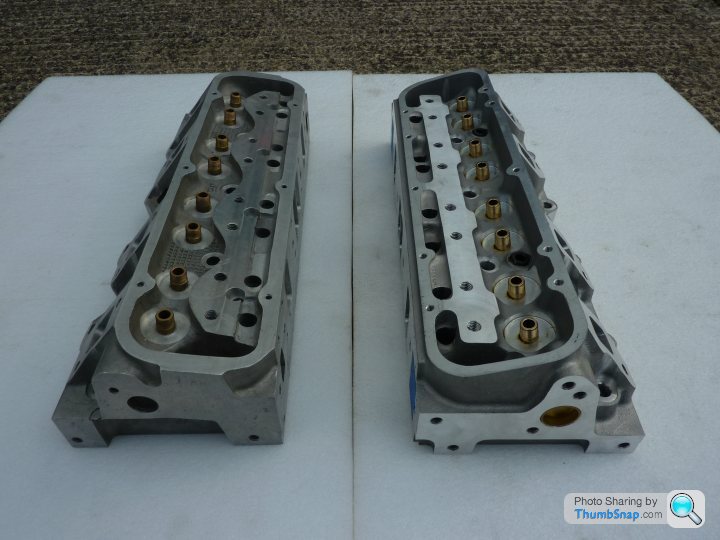
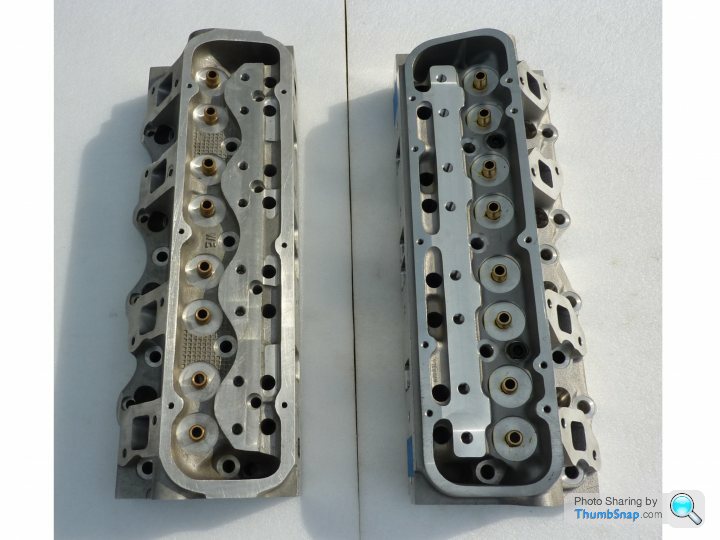
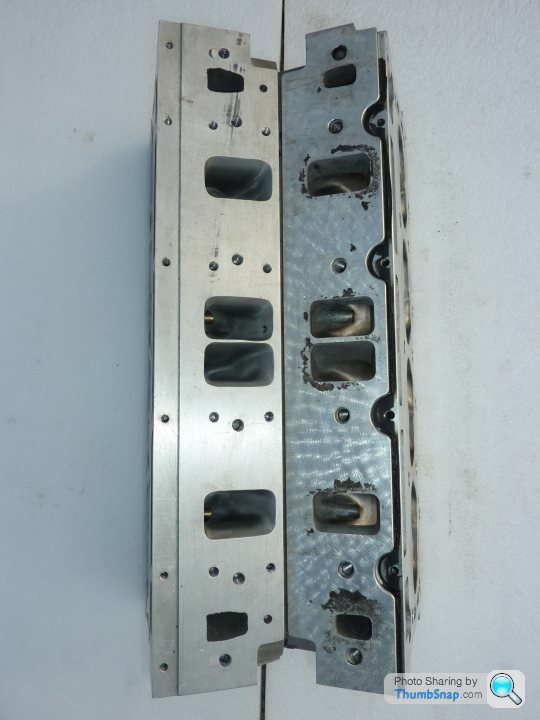

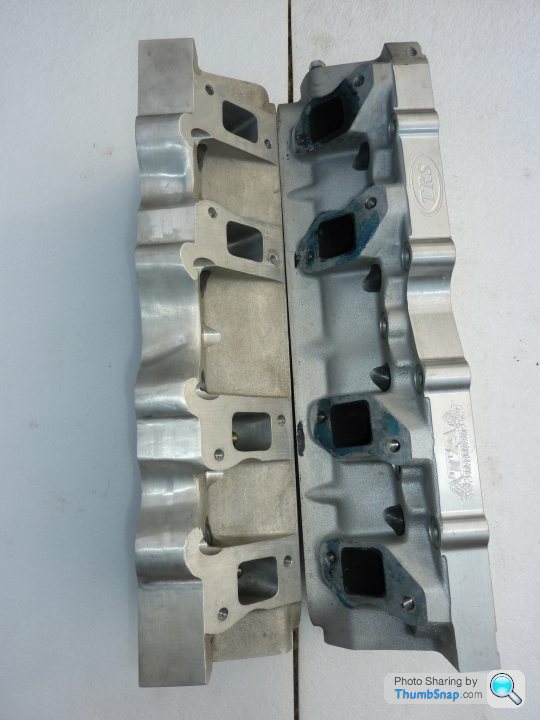
I quote 'Imitation is the highest form of flattery'
Wildcat600
I have also noticed that a certain tuner in Australia is no longer promoting Wildcat products, instead he is now selling TA Heads as his product.
Some photos showing the Wildcat cylinder head on the left, TA version on the right.





I quote 'Imitation is the highest form of flattery'
Wildcat600
Gassing Station | Griffith | Top of Page | What's New | My Stuff





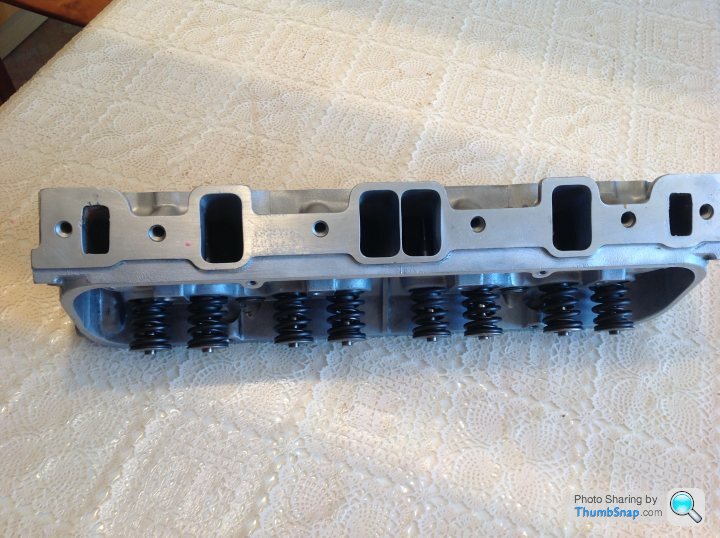
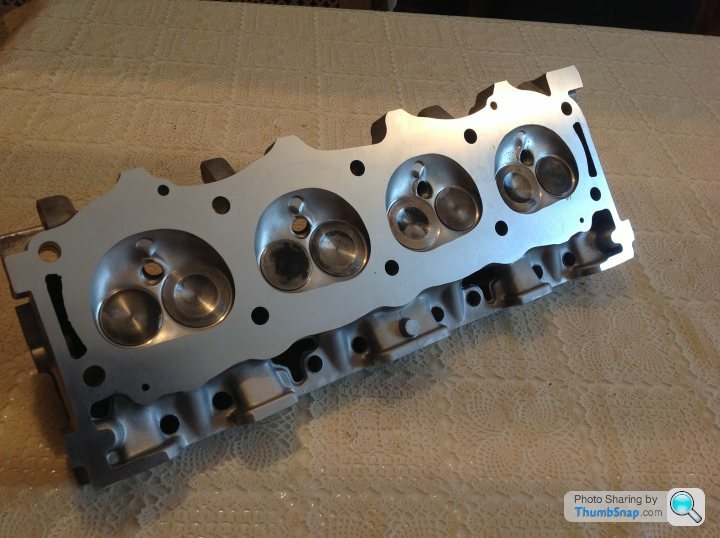
 had to make a choice and went down the merlin route those days
had to make a choice and went down the merlin route those days